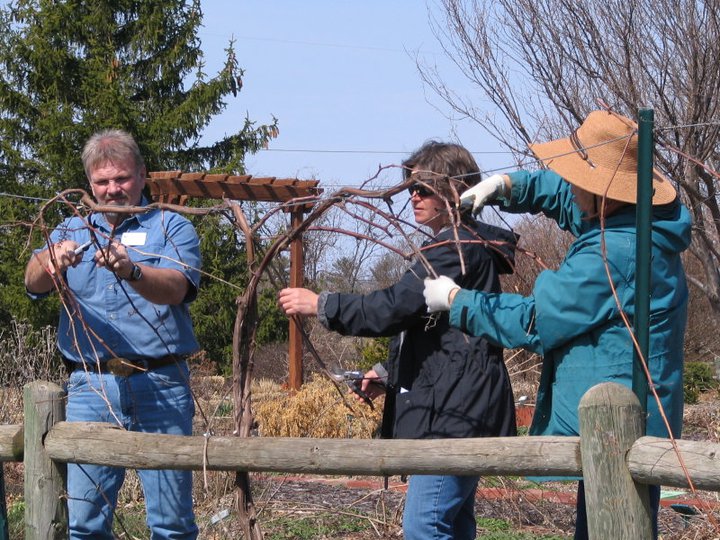Fruit Garden
Fruit cultivars can be found scattered throughout the demonstration garden at The Botanical Center. Grapevines, a plum tree, a sour cherry tree, brambles and apple cultivars are not confined to any one space. It is well worth the hunt to locate them when they’re in bloom, but visit often. It is an educational experience watching the progression from blossoms to fully ripened fruit.
Growing Fruit
Growing fruit is not easy. There can be many obstacles: the weather probably won’t cooperate, many cultivars lack disease resistance, spraying and pruning schedules can be complicated, and the battle against insects and pesky animals is never ending. Some trouble with thieving raccoons has left more than one home fruit grower wondering what a coon skin is worth these days, and could it possibly bring in enough money to just buy a bushel of fruit.
So why do we bother? Because it is as American as apple pie and a summer of ripe red strawberries and cool watermelons. We can hardly wait for the blueberries, peaches, cherries, and pears. Nothing is more exquisite than biting into a ripe warm peach and having its juice trickle down your chin. Jellies, jams, and cobblers lead us into an autumn season of persimmons, apple cider and pumpkins. We bother because fruits are delicious and nutritious and can be more affordable when homegrown. We eat fruits fresh or frozen, cook them, preserve them or ferment them into fine wines. Homegrown fruit can be of the highest quality and its freshness is guaranteed. Some people find it comforting to know exactly how and where it was grown, especially when it is in their own backyard.
Of course Mother Nature has always managed to produce wild fruit without our assistance: blackberries, raspberries and gooseberries remain a source of food in the area for humans as well as for wildlife. The good news is that we are no longer forced to brave the brambles, fending off the chiggers and ticks to get at those delicious berries… thorn-less varieties can simply be planted into our very own gardens.
The variety of fruits suitable for cultivating here in Missouri is extensive. Check it out. Trees, vines, or plants… it’s your choice. Just remember to do the research and choose the best cultivars from the many disease resistant recommendations. That makes successfully growing fruit much easier. You might even find that it is indeed worth the bother.
For More Information:
The University of Missouri extension has numerous publications to download that cover a wide array of topics such as:
• Pruning raspberries, blackberries, gooseberries, currants, and elderberries (G6000)
• Pollinating fruit crops (G6001)
• Fruit Cultivars for Home Plantings (G6005)
• Fruit Spray Schedules for the Homeowner (G6010)
• Fire Blight (G6020)
• Home Fruit Production: Apples (G6021)
• Home Fruit Production: Peach and Nectarine Culture (G6030)
• Common Tree Fruit Pests (NCR63)
* Submitted by Debra Rainey, 2015 Master Gardener trainee

